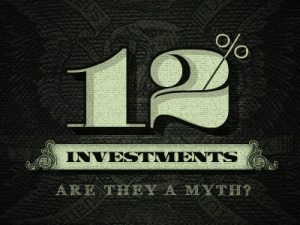 Have you ever heard to expect a 10-12% return if you correctly invest in the stock market? I’ve heard that, many times. Sure, others are out there promising massive returns on penny stocks and other immediately gratifying—but highly illusive—investment options. As we move forward it’s key to understand the difference between average returns and annualized returns.
Have you ever heard to expect a 10-12% return if you correctly invest in the stock market? I’ve heard that, many times. Sure, others are out there promising massive returns on penny stocks and other immediately gratifying—but highly illusive—investment options. As we move forward it’s key to understand the difference between average returns and annualized returns.
Let’s assume the 10-12% promise of return is true. That means investing $10,000 per year with a return of 11% would bring in a little over $700,000 in 20 years. That’s a great return, right? Yes, it is. Not bad at all.
Unfortunately, it’s not as good as a return as we may think. We all know that inflation cuts out some of the wind before our sails, but hey, whaddya gonna do? When looking at the promise of a solid $700,000, there are some other reasons why we can’t rely on that 10-12% return:
Average Returns vs. Annualized Returns
The first roadblock to averaging an 11% return is the use of “average annual returns.” This is something the financial industry uses to make past returns look better than they actually are.
It’s a number calculated by pulling an average of annual returns over a specified period of time. Say you own a single stock valued at $1,000. Its value increased by 100% in the first year and lost 50% in the following year. 50 subtracted from 100 and divided by two will give us a 25% annual average return. We would expect our value to increase to $1,250.
In actual experience, our $1,000 would have increased to $2,000, then decreased back to $1,000. You could argue we may have actually LOST money assuming inflation. Ultimately, that’s an average 0% increase over two years.
During seasons of highly volatility, the more distorted the numbers are. The above example is extreme, but even a small difference in returns make an enormous impact.
Per this website, average annual return of the S&P 500 was around 9.6% from 1992-2011. BUT, the compounded annualized return was around 7.8%. That might not seem like a big difference but $10k a year over 20 years at a 9.6% return is about $600k. At a 7.8% return, it’s a little over $480k. That is a delta of $120,000. The longer the time the bigger that delta gets, and with greater volatility, our compounded annualized return is impacted heavily as well.
Lump Sum v. Systematic Investing
Both the average annual and the compounded annualized returns are based on investing a lump sum of money at the beginning of 1992. That works great when you invest in the middle of a long term bull market but not so great when you’re investing over time into a market with lower returns near the end of the last 20 years as most people have actually been doing.
According to the latest Dalbar report, someone investing systematically from 1992-2011 would only have earned about a 3.2% compounded annualized return compared to the 7.8% return if they invested all at once in 1992. If we panicked and stop contributing or even bailed out of the market during the downturns, our returns could have been even less.
A recent Fidelity study showed that investors who got out of the market during the 2008 financial crisis only earned back 2% of their portfolio as of the middle of last year while those who stayed the course, earned back 50%. Those who continued contributing did even better, earning 64%, while those who stayed invested but stopped contributing earned 26%.
Mutual Fund Fees and Trading Costs
There of course are direct costs to trading, on the way in and on the way out.
Taxes
Uncle Sam thanks you for taking risk and making capital gains. He gladly takes his cut, assuming you were on the winning side of the transaction.
Now if you didn’t win in a particular year, please be aware that you can get a tax deduction. It’s just unlikely to be 15%…
Inflation
If inflation averages out to be around 3% over a long period of time, you’ll want to deduct that as well from the original $700,000 we discussed.
What Can We Do?
The answer isn’t to abandon investing or stocks altogether. We of course have to invest somewhere. Which can include real estate, businesses, bonds, gold and more. But diversity is key, so don’t give up on buying a piece of corporate pie.
Roth accounts help mitigate the tax impact of stock market investing—don’t be lost on that!
Most importantly, we can assume a lower return into our planning calculations. Instead of assuming a 10-12% return, we might want to plan on a 6-9% return. Yes, that means we’ll have to save more to achieve our goals. If the stock market beats our expectations then we’ll just have more money for retirement and be able to do so earlier. But we don’t know what the average return will be in the future, and we don’t know what how Uncle Sam will be billing us 30 years from now. Therefore we can plan ahead and continually educate ourselves!
[Featured image by http://dribbble.com/ShaneHelm]









